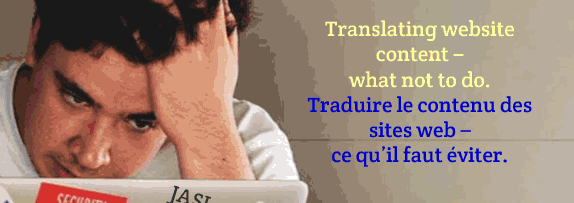When translating your website there are some mistakes you should be aware of, so that you can avoid making them. Here are the most common mistakes to avoid:
Try to avoid using translation programs and tools, they will translate your website word for word, but won’t check to see if the translation makes sense or serves its purpose to you.
Don’t translate your website word for word. Remember each country and culture is different, as are turns of phrase and the way things are worded. To have an effective impact on your audience you must tailor the writing to your audience specifically. Furthermore, word for word translations often lead to a number of grammatical errors in the translated text, with sentences ‘muddled up’ because of the different ways language structure their sentences.
Don’t forget what your main goal is, what you are hoping to achieve from your website, if you are selling goods or services, make sure your audience knows this. Whatever the purpose of your website, make sure this comes across.
Don’t ignore the importance of SEO and keyword in your text, and don’t forget that the keywords vary from country to country. Also ensure you conduct adequate keyword research and analyse it to ensure it will drive the right traffic to your site.
Avoid using a translator that only has a vague understanding of the language you want to translate into, it is always best to use a native speaker if possible, and don’t forget to check out your translator or translation services to ensure they are high quality.
Don’t forget to check your website still looks appealing once it has been translated, and that all text is visible. Often when words are translated they change in size, sometimes meaning they don’t always fit into the space provided when the website was created.
Don’t forget to proofread your translated website, and have other people, preferably native speakers of the language it’s been translated to, read your website to ensure it is accurate.
If you choose to use a translator or translation services, try not to hold back too much information about the purpose of your website. The more information your translator has the more specific and accurate your translated web content will be.
Avoid using figures of speech, clichés, plays on words, humour and puns, they may not translate properly, and even if they do they may not be understood.
Avoid translating everything on your website, even the waffle, just translate the important information and the things people need to be able to understand for your website to serve its purpose. This will save you a great deal of time and stress (if you are translating the content yourself) or money (if you hire a translator or translation service).
Don’t avoid using a translator or translation services because you consider it to be expensive or any other preconceived ideas you have of translation services. They generally have professional and qualified translators working for them, and because they have a number of translators they can complete higher volumes of work in shorter time frames. Just be sure to check our your translator or translation services, request a sample before agreeing or paying anything, and check the translation writing skills.
Don’t think that just because you’ve translated a sentence to one language and back again, without impacting upon the content, that the translation has worked perfectly, ‘back-translating’ should not be relied upon.
Your website is the face of your business, in order for it to be effective it has to be perfect, so consider spending a little money (and saving a lot of stress for yourself) by hiring a professional to translate your website for you, helping your website to take the world by storm.





